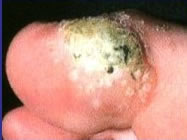Verrucae
Verrucae
 Verrucae are caused by the H.P.V. (Human Papilloma Virus) and are no different to warts found anywhere else on the body, with the exception that they tend to grow inwards if they are on the weight bearing surface of the foot, and therefore appear to have a flat top. Although some verrucae are not painful (and may often go unnoticed for many months), some are extremely tender as they are effectively areas of swollen tissue which press on the nerve endings in the skin.
Verrucae are caused by the H.P.V. (Human Papilloma Virus) and are no different to warts found anywhere else on the body, with the exception that they tend to grow inwards if they are on the weight bearing surface of the foot, and therefore appear to have a flat top. Although some verrucae are not painful (and may often go unnoticed for many months), some are extremely tender as they are effectively areas of swollen tissue which press on the nerve endings in the skin.
The verruca virus speads through contact and is therefore often contracted in places where people go barefoot, such as swimming pools and gym changing rooms. If you want to guard against picking up a verruca, rubber verruca socks which are found in sports equipment shops and swimming pools act as a physical barrier to stop the foot coming into contact with possibly contaminating surfaces.
Children and occasionally adults will sometimes develop an immunity to a verruca over a period of time and their immune system will remove the verruca automatically, so if a verruca is present for less than three months, or is not painful, or does not appear to be spreading or growing larger, the best course is often to leave it alone and see if it disappears by itself.
In cases where verrucae are long standing (i.e. more than three months), or spreading, or painful, treatment should be considered. In cases of small painless verrucae, the first option should be the use of a mild verruca paint, available in most chemists, which should be applied daily for three weeks. This contains an acid which removes the verruca layer by layer, and is often an effective treatment for small verrucae.
Professional treatment is recommended in more complex cases. There are several routes which can be followed but the most favored treatments fall into one of three categories:
* Caustic treatment – this uses acids to gradually strip away the verruca. Treatment is weekly and will take varying amounts of time, depending on the depth of the verruca.
* Electrosurgery – this refers to burning the verruca away using an electrical current, performed under a local anaesthetic. It removes the verruca immediately but leaves a small wound which will need to heal. (Some people confuse this with “laser”, which is a different treatment and still very much in the developmental stage).
* Cryosurgery – this uses freezing to cause a blister and stimulate the bodies own immune system to attack the verruca. Treatment is repeated weekly until the verruca clears.
* Needling – In the same way that cryosurgery uses cold to trigger the immune system, the verruca is painlessly treated with a needle under a local anaesthetic with the intention of causing an immune response. This treatment is convenient and usually only needs to be performed once.
The treatment of choice will depend on several factors including the patients age, medical history, pain tolerance, and lifestyle, and also how deep and wide the verruca is. Your Podiatrist will be able to discuss the above options and advise you appropriately at a consultation. Please note that there are many other methods for treating verrucae; the above section lists only the most widely used treatments.
